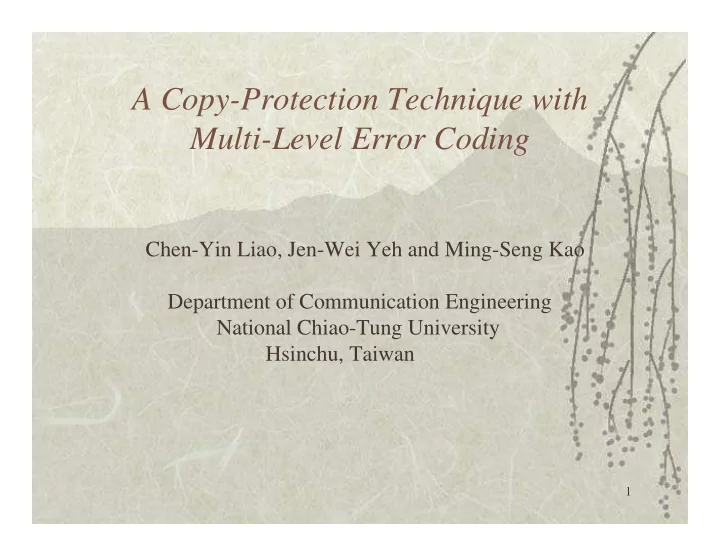

A Copy-Protection Technique with Multi-Level Error Coding Chen-Yin Liao, Jen-Wei Yeh and Ming-Seng Kao Department of Communication Engineering National Chiao-Tung University Hsinchu, Taiwan 1
Contents � Introduction � Coding scheme � Analysis results � Conclusions 2
Copy protection of optical disks � No method can absolutely prevent unauthorized copying of optical disks. � Approach: increase the difficulty of disk copying. 3
Idea X-bits : � special bits with reflectivity (R) within a specified range. � If the range of R is rather limited, it will be very difficult to reproduce X-bits. � Challenge: – limit R to a very small range. – guarantee successful play of authorized disks. – reject unauthorized copies definitely . 4
X-bits � Normal bits: with normalized reflectivity equal to 1 or 0. � X-bits: have reflectivity 0.5- α < R < 0.5+ α . (e.g. α =0.01, 0.49 < R < 0.51). � If α is small enough, it will be very difficult to reproduce X-bits, even for professional pirates. 5
Double-read process � X-bits appear in the lead-in sector of the disk only. � X-bits can be detected via double-read process: – if the outcomes of two reading processes are different, the corresponding bit is assumed to be an X-bit. – Otherwise, it is taken as a normal bit. � The extra time for double-read process is little. 6
Error probability of X-bits � P e is a function of α n = α / σ n . ( σ n 2 : noise variance). � P e is high, with P e(min) = 0.5. � X-bits: used as potential errors in the disk. λ 7
Design idea � X-bits : sets a hardware obstacle to disk copying . � Multi-level error coding : – limit α n to a very small range ( α n < α c, ). – if α n is out of range, the disk content will be lost. 8
Proposed scheme � The content is scrambled by an encryption key before stored in the disk. � This key is encoded by the multi-level error coding plus the X-bit coding. � The encoded key with X-bits is stored in the lead-in sector of the disk. � On playing the disk, the key should be correctly decoded so as to de-scramble the content . 9
Goal of coding scheme � Achieve sharp discrimination of α n . – if α n < α c , then P key → 1. – if α n > α c , then P key → 0 . 10
Encoding process (n,k) RS-code K C 1st-level coding N 1 1st-level FC’s Lth-level coding X-bit coding N L Optical Lth-level FC’s disk 11
Decoding process Optical X-bit decoding N L disk Lth-level FC’s Lth-level decoding N 1 1st-level FC’s 1st-level decoding (n,k) RS-decoder K C 12
Detection probability of codewords 13
Discussion � The detection probability varies with decoding level. � A sharp cutoff exists in the detection probability of codewords after the 1st- level decoding. 14
Detection probability of the key 15
Discussion � For authorized disks with α n < α c , successful playing is guaranteed since P key → 1. � For copied disks with α n > α c , it will have no chance to be played since P key → 0 . � Different RS codes can be used to specify α c . 16
Discussion � If α c is small enough, X-bits can only be made with very-high precision machines. � If these machines are controlled by few disk manufacturers, it will be very difficult and costly to access them. � If double-read process is a standard procedure in disk players and those high-precision machines are well controlled, professional piracy will be effectively prevented. 17
Conclusions � A new copy protection technique based on multi-level error coding is proposed. � The multi-level coding leads to a sharp cutoff in the detection probability of the encryption key. � This sharp cutoff effect is sued to set a hard obstacle for disk copying. � The proposed scheme is feasible to effectively prevent professional piracy. 18
Thank You 19
Recommend
More recommend